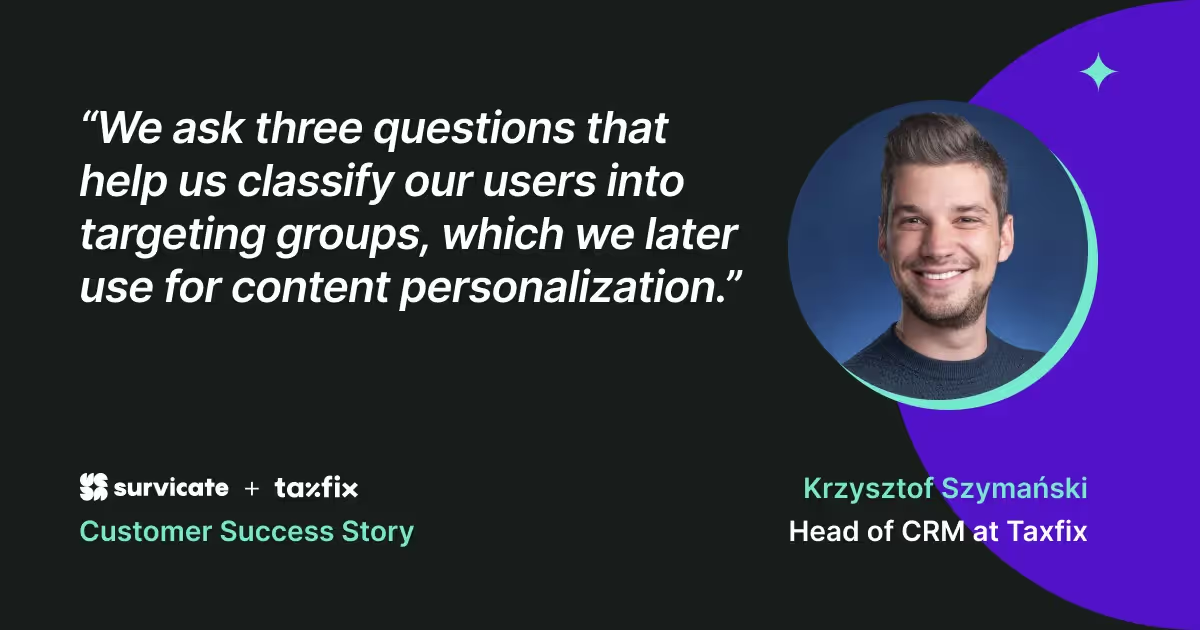Tl; dr;
- AI Surveys: AI surveys personalize questions in real-time, leading to more reliable data. Machine learning predicts trends, helping anticipate market shifts.
- Open-Text Analysis and Categorization: AI processes open-text responses, extracting themes and categorizing them for nuanced customer insights without human bias.
- Sentiment Analysis through AI: AI algorithms rapidly assess consumer sentiment from text data, offering immediate insights into public perception of brands or products.
- Predictive Analytics and Consumer Behavior: AI forecasts future consumer behavior, informing product development and marketing strategy decisions.
- Cross-Platform Analytics: Integrating user data from multiple digital platforms provides a comprehensive view of customer behavior, optimizing marketing strategies.

If you thought market research was as exciting as watching paint dry, prepare for a plot twist.
Understanding the latest market research industry trends is crucial for businesses and marketers aiming to stay ahead of the curve. These insights pinpoint what's influencing the ever-changing consumer preferences and suggest how to adjust your strategies effectively.
Dive into our rundown of the top five market research trends set to dominate in 2025 and discover how tapping into these movements can give your business the edge it needs to thrive.
Trend 1: AI and machine learning
Nobody's surprised we start our market research industry trends countdown with artificial intelligence (AI) and machine learning. They are reshaping market research, offering powerful tools for analyzing complex datasets and extracting actionable insights.
AI surveys
AI surveys are transforming how we collect and interpret data. It also makes your job faster. With Survicate, creating a new survey with AI takes no more than 25 seconds. You need to describe your needs first.

Open-text analysis and feedback categorization
Open-ended questions provide rich, qualitative data that are invaluable to market researchers. AI excels in processing unstructured data, extracting themes, and categorizing responses without human bias.
This saves time and reveals customer insights that might be overlooked in manual analysis. Through natural language processing (NLP), AI tools can understand context, sarcasm, and nuanced language, turning open-text responses from your target audience into quantifiable data.
Sentiment analysis through artificial intelligence
It is a key component of market research that benefits significantly from AI. Advanced algorithms analyze text from social media, reviews, and customer feedback to determine the sentiment behind words, whether positive, negative, or neutral.
This automated process allows for the rapid assessment of consumer feelings towards a brand or product, providing a clear picture of public perception.
Predictive analytics and consumer behavior
Beyond analyzing current data, AI is instrumental in predictive analytics. By examining historical data and current market conditions, AI models can accurately forecast future consumer behavior.
These predictions enable businesses to make informed decisions about product development, marketing strategies, and inventory management.
Real-time data collection and processing
One of the most significant advantages of AI in market research is its ability to process data in real-time. This capability means you can react quickly to emerging trends and consumer feedback, staying ahead of the competition.
Real-time analytics also allows for the continuous improvement of products and services, as you can implement changes rapidly based on the latest consumer insights.
Incorporating AI and machine learning into market research methodologies provides a competitive edge, offering deep, data-driven insights essential for strategic decision-making in 2024.
Trend 2: Cross-platform analytics
Cross-platform analytics is essential for understanding consumer behavior across various digital environments.
It involves collecting and analyzing user behavior data across multiple digital platforms, such as websites, mobile apps, or CRM systems, to understand how users interact with content and services, providing a comprehensive view of the customer journey and improving marketing strategies.
The goal is to integrate data from all these sources to track and analyze the customer's interactions and experiences across different touchpoints.
Deeper insights from your customers
Cross-platform analytics examines interactions across mobile, desktop, and other devices to capture the full spectrum of consumer behavior. This approach provides a complete view of demographic data, habits, and preferences, revealing how customers engage with content and services in different contexts.
By integrating data from all platforms, you can map the digital journey, identifying key touchpoints and opportunities for engagement.
Improving customer journey understanding
A thorough analysis of the customer journey is crucial for brand strategy. Cross-platform analytics illuminates consumers' path from initial awareness to final purchase and beyond.
This visibility allows brands to craft tailored messages and offers that resonate with their audience at every stage of the journey, improving conversion rates and customer loyalty.
Advanced tracking and attribution
Effective cross-platform analytics hinges on sophisticated tracking and attribution models. These systems must accurately link user actions to the correct device and session, accounting for the complexity of multiple device usage.
Accurate attribution informs strategic decisions, ensuring that marketing efforts are evaluated correctly and budgets are allocated to the most effective channels.
Real-time decision-making
With real-time data, brands can make swift decisions to capitalize on emerging trends or address issues as they arise. This agility is vital in a fast-paced digital marketplace where consumer preferences can shift quickly.
Data integration challenges
Integrating valuable data from disparate sources remains a challenge. Ensuring data quality and consistency across platforms is paramount for reliable analysis.
You must invest in data and feedback management tools to unify and standardize data for accurate cross-platform insights.
Cross-platform analytics is a powerful solution to deliver tailored, personalized customer experiences. You can optimize your marketing strategies to drive tangible effects by tracking and attributing consumer behavior across devices.
Trend 3: Mobile-first research
With most internet users accessing content via mobile devices, mobile-first research ensures that studies are designed for consumers' platforms.
This approach allows for the capture of 'micro-moments,' the instances when consumers turn to their devices for quick decision-making, which is critical for understanding real-time consumer behavior.
Mobile surveys
Surveys and studies must be optimized for mobile interfaces to maximize response rates and data integrity.
This means designing concise, easy-to-navigate, responsive surveys across all mobile devices. The goal is to make participation as frictionless as possible, encouraging higher respondent engagement.
Look for survey tools that offer mobile surveys, like Survicate. You just need to install the mobile SDK, and you can start collecting honest feedback from your customers.
Enhancing data quality
Mobile optimization also improves data quality. By accommodating the user's mobile experience, researchers can reduce the likelihood of incomplete or inaccurate responses, which can occur when surveys are not mobile-friendly. This leads to more reliable data for analysis.
Real-time data collection
Mobile-first research allows for real-time data collection, providing immediate insights into consumer behavior. This enables businesses to quickly adapt to consumer needs and trends, offering a significant competitive advantage.
Integrating location-based insights
You can take advantage of mobile GPS capabilities to gather location-based insights, offering context to consumer behaviors and preferences. This geo-specific data is invaluable if you're looking to tailor your offerings to regional market conditions.
Mobile-first research aligns with contemporary consumer habits, offering a relevant and effective approach to gathering market insights in 2024.
By prioritizing mobile platforms and optimizing methodologies for these devices, researchers can obtain high-quality data that reflects the nuanced behaviors of today's consumers.

Trend 4: Behavioral analytics
Behavioral analytics delves into the vast amounts of big data to discern the driving forces behind consumer behaviors and decisions.
Uncovering consumer motivations
This trend involves analyzing detailed data sets to reveal patterns and trends in consumer actions. By leveraging big data, companies can predict future behaviors, tailor personalized experiences, and ultimately drive conversions by understanding what motivates their customers.
The rise of predictive modeling
Predictive modeling uses historical data to forecast consumer attitudes. By identifying the likelihood of future actions based on past behaviors, you can proactively adjust your strategies to meet anticipated market demands.
Growth of qualitative analytics
In contrast to the numerical focus of behavioral analytics, the growth of qualitative analytics represents a shift towards incorporating subjective data for a more nuanced market understanding.
Balancing numbers with narratives
While quantitative research offers a broad overview, qualitative analytics provides depth. It considers the human element by analyzing text responses, interviews, and other narrative data, giving context to the numbers.
Enhancing market understanding
Combining qualitative insights with quantitative data paints a comprehensive picture of the market. This holistic view helps businesses understand the 'what' and the 'why' behind consumer actions, leading to more informed decision-making.
Embracing mixed methods research
This approach allows for a more flexible and comprehensive market research, accommodating a wide range of consumer insights.
Behavioral analytics and the growth of qualitative analytics are crucial in understanding the market completely. Together, they enable businesses to tailor their strategies effectively, ensuring they meet their customers' evolving needs and motivations in 2024.
Trend 5: Personalization at scale
Personalization at scale is the strategic approach to delivering tailored marketing to vast audiences, which is crucial for enhancing customer satisfaction and loyalty.
Crafting customized messages
Personalized messages must be crafted using data-driven insights to engage a large customer base.
This involves segmenting audiences based on behaviors, preferences, and past interactions to deliver relevant content that resonates with individual consumers.
Leveraging machine learning
Machine learning algorithms are vital in analyzing customer data and predicting preferences.
This technology enables the automation of personalization, ensuring that each customer receives individualized attention without sacrificing efficiency.

➡️ Check how Taxfix boosts retention with personalized content
Personalization beyond email
While email has been a traditional medium for personalized marketing, expanding personalization across all digital touchpoints, including websites, apps, and social media, is essential.
Consistency across channels enhances the customer experience and reinforces brand loyalty.
Real-time personalization
Implementing real-time personalization techniques allows businesses to present offers and content that reflect the immediate context of a customer's journey.
This dynamic approach adapts to live interactions, improving engagement and conversion rates.
Measuring personalization effectiveness
To ensure personalization strategies are successful, it's important to measure their impact. Key performance indicators (KPIs) such as conversion rates, click-through rates, and customer lifetime value help gauge the effectiveness of personalized marketing efforts.
Personalization at scale is a powerful tool for businesses aiming to connect with their customers meaningfully. You can significantly improve customer satisfaction and foster loyalty by delivering customized marketing messages.
Try the best market research trends with Survicate
The market research competitive landscape is evolving rapidly, with AI and cross-platform analytics at the forefront of this transformation. Market research tools incorporating AI features are becoming indispensable as they manage and analyze feedback from various platforms, providing valuable insights that were once out of reach.
With its ability to conduct AI-powered surveys and perform open-text analysis, Survicate provides a comprehensive solution for businesses looking to stay ahead.
Survicate can help you keep pace with the rapid changes in market research and gain a deeper understanding of their customers. This understanding is crucial for creating effective, data-driven strategies that resonate with target audiences and drive growth.
To truly appreciate the impact of these advanced tools, consider trying Survicate for yourself. Start a 10-day free trial and experience all the Business Plan features. This hands-on approach will demonstrate how Survicate's innovative features can enhance market research efforts and inform strategic decisions.
You might also be interested in:













.svg)

.svg)



